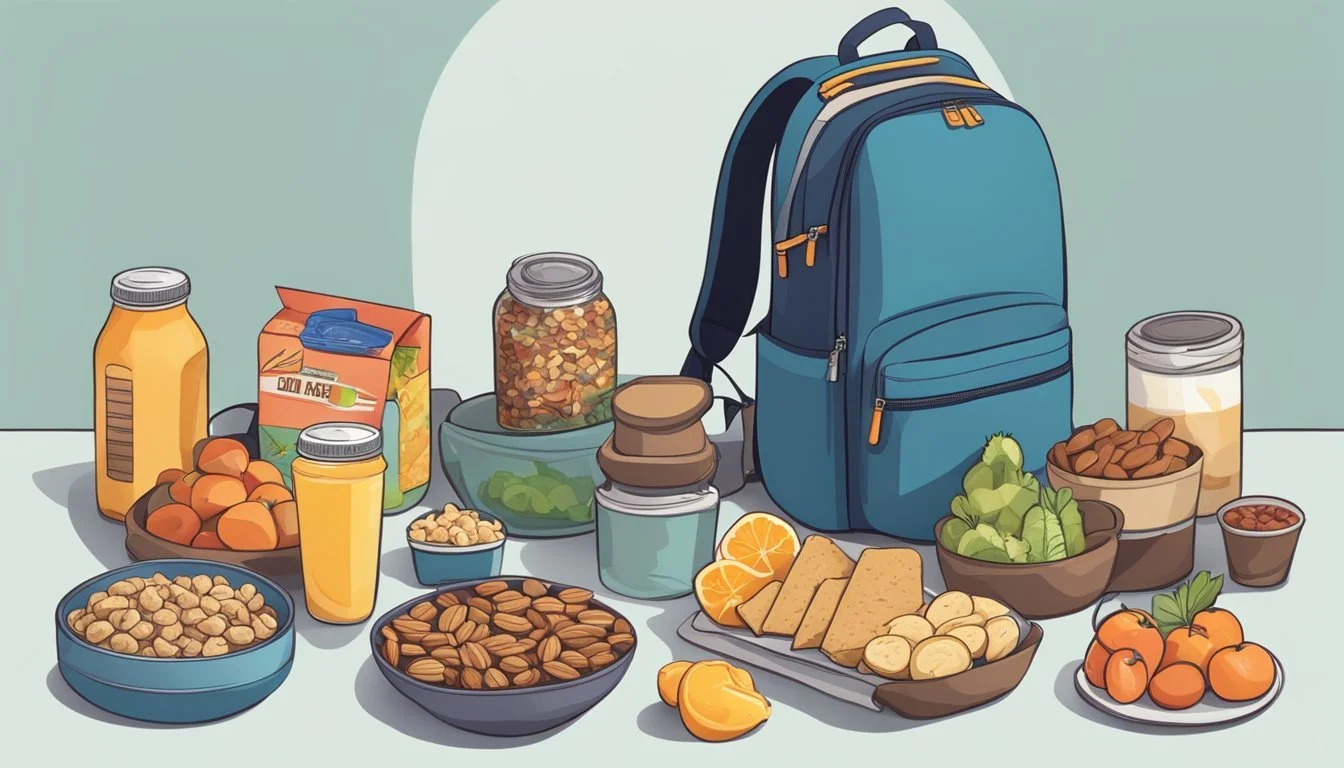6 Nutritious Snack Ideas for Diabetic Travelers to Stay Healthy on the Go
Traveling as a diabetic can be challenging, especially when it comes to finding suitable snacks that fit dietary needs. These challenges can make it difficult to maintain blood sugar levels and find convenient options while on the move.
The key to managing diabetes on the go is having a variety of nutritious snacks readily available. This article aims to provide practical solutions for diabetic travelers by offering snack ideas that are both healthy and portable.
1) Almonds and Walnuts Mix
Almonds and walnuts make for an excellent travel snack, especially for diabetics. They are nutrient-dense and easy to carry, fitting neatly into a small container or resealable bag.
Almonds provide over 15 vitamins and minerals, including magnesium, vitamin E, and fiber. A one-ounce serving offers a satiating blend of healthy fats, protein, and carbohydrates.
Walnuts complement almonds with their own impressive nutritional profile. They are rich in omega-3 fatty acids, which contribute to heart health. Eating a mix of these nuts can help maintain balanced blood sugar levels.
This snack requires no preparation and is shelf-stable, making it ideal for travel. The balance of macronutrients helps keep energy levels steady throughout the day.
By combining these two types of nuts, travelers can enjoy a tasty and healthful option that supports glucose control and overall well-being.
2) Greek Yogurt with Berries
Greek yogurt with berries offers a balanced and nutritious snack option for diabetic travelers. Greek yogurt is rich in protein and low in carbohydrates, making it an excellent choice for managing blood sugar levels.
Fresh berries such as strawberries, blueberries, and raspberries add natural sweetness and are high in fiber and antioxidants. This combination helps keep the snack both tasty and diabetic-friendly.
When choosing Greek yogurt, opt for the plain, unsweetened variety. This helps avoid any hidden sugars that can spike blood glucose levels.
A sprinkle of chia seeds or a handful of nuts can add an extra crunch and boost the nutritional value of this snack.
This simple yet satisfying treat is easy to pack and doesn't require any complicated preparation, making it perfect for travelers.
3) Veggie Sticks with Hummus
Veggie sticks with hummus make an excellent snack for diabetic travelers. This combination not only offers a delightful crunch but also packs a nutritional punch. The vegetables provide essential vitamins and fiber, while hummus adds a dose of healthy fats and protein.
For a well-balanced snack, consider using a variety of colorful vegetables. Carrots, celery, bell peppers, and cucumbers are great options. These vegetables contribute to maintaining stable blood sugar levels due to their low glycemic index.
Hummus, made from chickpeas, is rich in protein and fiber, which helps in controlling hunger and maintaining energy levels. It also contains healthy fats, mainly from olive oil and tahini, promoting heart health.
Travelers can easily pack veggie sticks and hummus in small containers. This snack is convenient and doesn't require refrigeration for short periods, making it perfect for on-the-go lifestyles. Portion control is important, so a single serving of hummus and a handful of veggie sticks suffice.
Incorporating veggie sticks with hummus into a traveler's diet can support overall health management. This snack is practical, nutritious, and delicious, making it an ideal choice for those managing diabetes while traveling.
4) Apple Slices with Peanut Butter
Apple slices with peanut butter offer a balance of carbohydrates, healthy fats, and protein, making them an excellent snack for diabetic travelers. Apples provide a source of vitamins, fiber, and natural sweetness, which helps manage blood sugar levels.
Peanut butter adds healthy fats and protein, ensuring a longer feeling of fullness. When selecting peanut butter, choose one without added sugars to keep the snack as healthy as possible. This combination not only satisfies cravings but also supports sustained energy levels.
Preparation is simple and quick. Slice a medium apple into wedges and pair it with two tablespoons of peanut butter. This snack is convenient to carry, requiring minimal packing. It can be enjoyed anywhere—whether on a plane, in a car, or during a sightseeing walk.
By combining fresh fruit with nut butter, diabetic travelers can enjoy a nutritious snack that caters to their dietary needs while on the go.
5) Hard-Boiled Eggs
Hard-boiled eggs are an excellent snack choice for diabetic travelers. They are easy to prepare and carry, making them perfect for an on-the-go lifestyle.
Each egg packs approximately 6 grams of protein, which helps maintain stable blood sugar levels. They also contain healthy fats and essential vitamins with zero carbs or sugar.
With their dense nutritional profile, hard-boiled eggs offer a balanced mix of nutrients that support energy levels throughout the day. They are also versatile, allowing for easy incorporation into a variety of meals or snacks.
A simple yet effective option, hard-boiled eggs can be combined with other snacks like vegetables or nuts for a more substantial meal. This makes them not only a healthy choice but also a convenient one for those managing diabetes while traveling.
6) Cottage Cheese with Pineapple
Cottage cheese paired with pineapple offers a healthy and tasty snack for diabetic travelers. This combination provides a balance of protein and carbohydrates, with cottage cheese being high in protein and low in carbohydrates, and pineapple adding a touch of sweetness.
Cottage cheese has a low glycemic index, which means it has minimal impact on blood sugar levels. This makes it a suitable option for individuals managing diabetes. Pineapple, though sweet, can be consumed in moderation due to its anti-inflammatory properties, which may help reduce diabetes complications.
The creamy texture of cottage cheese contrasts well with the juicy pineapple, making it an enjoyable snack. This mix is also easy to prepare and portable, which is a plus for travelers.
Combining these two ingredients can help keep hunger at bay while providing essential nutrients. The protein in cottage cheese helps with satiety, while the pineapple offers vitamins and minerals.
For variety, travelers can experiment with different fruits like berries or apple chunks. This flexibility allows them to enjoy a nutritious and satisfying snack on the go, while still managing their blood sugar levels effectively.
Understanding Nutritional Needs for Diabetic Travelers
When traveling, diabetic individuals must pay special attention to their nutritional intake to maintain stable blood sugar levels and overall well-being. Proper planning can ensure that they have access to balanced snacks that provide essential nutrients.
Managing Blood Sugar Levels on the Go
Maintaining stable blood sugar levels is crucial for diabetic travelers. Snacks rich in fiber, protein, and healthy fats help achieve this stability. Fiber-rich foods slow the absorption of sugar, preventing spikes in blood sugar. Examples include whole grains, raw vegetables, and fruits like apples or berries.
Protein helps sustain energy and manage hunger. Nuts, hard-boiled eggs, and lean meats are portable options that provide steady energy release. Healthy fats, found in avocados and seeds, further support blood sugar management by enhancing satiety and nutrient absorption.
Importance of Balanced Snacks
Balanced snacks are essential for providing a mix of nutrients. Snacks should ideally combine carbohydrates, proteins, and fats.
Carbohydrates: Choose low glycemic index options like whole grain crackers or dry cereal. These have a slower impact on blood sugar levels.
Proteins: Incorporate proteins such as yogurt, cheese sticks, or edamame. These snacks are easy to carry and provide crucial amino acids.
Fats: Healthy fats can come from nut butter packets or a small portion of nuts and seeds. They aid in satiety and offer sustained energy.
Ensuring a mix of these macronutrients in each snack helps maintain energy levels and prevent blood sugar swings, essential for any diabetic traveler.
Travel-Friendly Snack Preparation Tips
Selecting the right snacks and packing them effectively can make your travel experience smoother and ensure you stay on track with your nutritional needs. Focus on non-perishable items and creating easy-to-carry snack packs.
Choosing Non-Perishable Snacks
When traveling, non-perishable snacks are essential for convenience and longevity. Nuts like almonds, walnuts, and pistachios are excellent choices because they are rich in healthy fats and proteins. Additionally, beef jerky is a high-protein option that does not require refrigeration.
For a quick energy boost, consider granola bars that are low in sugar. Peanut butter single-serve tubs paired with whole-grain crackers provide a balanced snack rich in protein and fiber. Popcorn is another great option, being light and easy to store.
Packing Portable Snack Packs
Organizing your snacks into portable packs ensures easy access and portion control. Using small, resealable bags or containers helps keep items fresh and prevents spills. Labeling each pack with contents and nutritional information can save time when you're on the go.
For versatility, consider using a mix-and-match approach by combining different snacks like nuts, dried fruits, and whole-grain crackers in a single bag. It's also wise to pack an insulated bag for items that might partially perish or to carry a small reusable ice pack if you anticipate longer travel periods.
Proper preparation and packing can make a significant difference in maintaining a healthy diet while traveling.
Healthy Eating Habits While Traveling
Adopting healthy eating habits is crucial for diabetic travelers to maintain stable glucose levels. This involves proper hydration and understanding food labels to make informed dietary choices.
Staying Hydrated
Staying hydrated helps regulate blood sugar levels and improves overall health. Diabetic travelers should drink at least 8 glasses of water daily. Carrying a reusable water bottle ensures easy access to water.
Avoid sugary drinks like soda or sweetened beverages. These can cause blood sugar spikes. Opt for water, unsweetened tea, or sparkling water. Electrolyte-enhanced water may also be beneficial, especially in hot climates.
Hydration can also be maintained by consuming water-rich foods. Cucumber, celery, and watermelon are good choices. Frequent hydration breaks, especially during long journeys, help in maintaining energy levels.
Reading Food Labels
Reading food labels allows diabetic travelers to monitor carbohydrate intake and avoid hidden sugars. Check the “Total Carbohydrates” section to understand how much sugar is present in a serving.
Ingredients are listed by quantity. If sugar or its alternatives appear early on the list, it’s best to avoid or limit that product. Look for added sugars identified by names like high-fructose corn syrup, cane sugar, or honey.
Pay attention to serving sizes. A package might contain multiple servings, affecting total carbohydrate and sugar intake. Nutrient labels also provide fiber content, which can help manage blood sugar spikes.
Understanding food labels empowers travelers to make healthier snack choices. It also aids in selecting foods with the right balance of protein, fiber, and fats to keep glucose levels stable.









